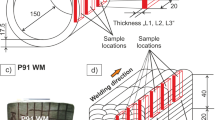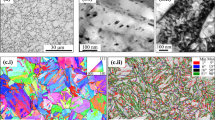Abstract
Hydrogen-assisted cracking is a critical combination of local microstructure, mechanical load and hydrogen concentration. Welded microstructures of low-alloyed creep-resistant Cr-Mo-V steels show different hydrogen trapping kinetics. This influences the adsorbed hydrogen concentration as well as the diffusion by moderate or strong trapping. A common approach to describe hydrogen traps is by their activation energy that is necessary to release hydrogen from the trap. In the present study, Cr-Mo-V steel T24 (7CrMoVTiB10-10) base material and TIG weld metal were investigated. Electrochemically hydrogen charged specimens were analyzed by thermal desorption analysis (TDA) with different linear heating rates. The results show two different effects. At first, the microstructure effect on trapping is evident in terms of higher hydrogen concentrations in the weld metal and increased activation energy for hydrogen release. Secondly, it is necessary to monitor the real specimen temperature. A comparison between the adjusted heating rate and the real specimen temperature shows that the calculated activation energy varies by factor two. Thus, the trap character in case of the base material changes to irreversible at decreased temperature. Hence, the effect of the experimental procedure must be considered as well if evaluating TDA results. Finally, realistic temperature assessment is mandatory for calculation of activation energy via TDA.








Similar content being viewed by others
References
Hahn B, Bendick W (2008) Rohrstähle für moderne Hochleistungskraftwerke. 3R international 47:3–12
Heuser H, Jochum C (2002) Characterization of matching filler metals for new ferritic-bainitic steels like T/P 23 and T/P 24. In: Lecomte-Beckers J, Carton M, Schubert F, Ennis PJ (eds) Materials for advanced power engineering 2002. Forschungszentrum Jülich, Jülich, Germany
Dhooge A, Vekeman J (2005) New generation 21/4Cr steels T/P 23 and T/P 24 weldability and high temperature properties. Weld World 49(9-10):75–93. https://doi.org/10.1007/bf03266492
Nowack R, Goette C, Heckmann S (2011) Quality management at RWE using T24 boiler material as an example (in German). VGB Powertech Journal 11:1–5
Husemann RU, Devrient S, Kilian R (2012) Cracking mechanism in high temperature water-T24 root cause analysis program. In: NN 38th VDI-Jahrestagung Schadensanalyse in Kraftwerken. VDI-Wissensforum, Düsseldorf, Germany, pp 87–103
Hoffmeister H, Boellinghaus T (2014) Modeling of combined anodic dissolution/hydrogen-assisted stress corrosion cracking of low-alloyed power plant steels in high-temperature water environments. Corros Sci 70(6):563–578. https://doi.org/10.5006/1048
Garet M, Brass AM, Haut C, Guttierez-Solana F (1998) Hydrogen trapping on non-metallic inclusions in Cr-Mo low alloyed steels. Corros Sci 40(7):1073–1086. https://doi.org/10.1016/S0010-938x(98)00008-0
Albert SK, Ramasubbu V, Parvathavarthini N, Gill TPS (2003) Influence of alloying on hydrogen-assisted cracking and diffusible hydrogen content in Cr-Mo steel welds. Sadhana 28(3-4):383–393. https://doi.org/10.1007/bf02706439
Steppan E, Mantzke P, Steffens BR, Rhode M, Kannengiesser T (2017) Thermal desorption analysis for hydrogen trapping in microalloyed high-strength steels. Weld World 61(4):637–648. https://doi.org/10.1007/s40194-017-0451-z
ISO 17462-1:2004 Destructive tests on welds in metallic materials—cold cracking tests for weldments—arc welding processes, part 1: general
Blach J, Falat F, Sevc P (2011) The influence of hydrogen charging on the notch tensile properties and fracture behavior on dissimilar weld joints of advanced Cr-Mo-V and Cr-Ni-Mo creep resistant steels. Eng Fail Anal 18(1):485–491. https://doi.org/10.1016/j.engfailanal.2010.09.043
Dayal RK, Parvathavarthini N (2003) Hydrogen embrittlement in power plant steels. Sadhana 28(3-4):431–451. https://doi.org/10.1007/bf02706442
Rhode M, Steger J, Boellinghaus T, Kannengiesser T (2016) Hydrogen degradation effects on mechanical properties in T24 weld microstructures. Weld World 60(2):201–216. https://doi.org/10.1007/s40194-015-0285-5
Nevasmaa P, Laukanen A (2005) Assessment of hydrogen cracking risk in multipass weld metal of 2.25Cr-1Mo-0.25V-TiB (T24) boiler steel. Weld World 49(7-8):45–58. https://doi.org/10.1007/bf03263423
Pressouryre GM (1979) A classification of hydrogen traps in steel. Metall Trans A 10(10):1571–1573. https://doi.org/10.1007/BF02812023
Grabke HJ, Riecke E (2000) Absorption and diffusion of hydrogen in steels. Mater Tehnol 34(6):331–342
Hirth JP (1980) Effects of hydrogen on the properties of iron and steel. Metall Trans A 11(6):861–890. https://doi.org/10.1007/BF02654700
McNabb A, Foster PK (1963) A new analysis of the diffusion of hydrogen in iron and ferritic steels. Trans Met Soc AIME 227:618–627
Coudreuse L, Bocquet P, Cheviet L (1992) Hydrogen trapping in Cr-Mo steels for hydro processing reactors. PVP-Vol. 239/ MPC-Vol. 33, Serviceability of Petroleum, Process and Power Equipment, ASME
Brouwer RC (1993) Hydrogen concentration distribution in the wall of pressure vessels made of conventional and V-modified steels. Int J Pres Ves Pip 56(2):133–148. https://doi.org/10.1016/0308-0161(93)90091-7
Brouwer RC (1992) Hydrogen diffusion and solubility in vanadium modified pressure vessel steels. Scripta Metall Mater 27(3):353–358. https://doi.org/10.1016/0956-716x(92)90525-j
Coudreuse L, Bocquet P (1995) Hydrogen diffusion and trapping in Cr-Mo steels in hydrotreating reactors. In: Turnbull A (ed) Hydrogen transport and cracking un metals. Maney Publishing, London, United Kingdom, pp 227–239
Brass AM, Guillon F, Vivet S (2004) Quantification of hydrogen diffusion and trapping in 2.25Cr-1Mo and 3Cr-1Mo-V steels with electrochemical permeation technique and melt extraction. Metall Mater Trans A 35(5):1449–1464. https://doi.org/10.1007/s11661-004-0253-y
Parvathavarthini N, Saroja S, Dayal RK, Khatak HS (2001) Studies on hydrogen permeability of 2.25%Cr-1%Mo ferritic steel: correlation with microstructure. J Nucl Mater 288(2-3):187–196. https://doi.org/10.1016/S0022-3115(00)00706-6
Wei FG, Tsuzaki K (2005) Response of hydrogen trapping capability to microstructural change in tempered Fe-0.2C martensite. Scr Mater 52(6):467–472. https://doi.org/10.1016/j.scriptamat.2004.11.008
Nagao A, Martin ML, Dadfarnia M, Sofronis P, Robertson IM (2014) The effect of nanosized (Ti,Mo)C precipitates on hydrogen embrittlement of tempered lath martensitic steel. Acta Mater 74(1):244–254. https://doi.org/10.1016/j.actamat.2014.04.051
Rhode M (2016) Hydrogen diffusion and effect on degradation in welded microstructures of creep-resistant low-alloyed steels. BAM-Dissertationsreihe 148, Berlin, Germany
EN 1011-2:2011 - Welding—recommendations for welding of metallic materials, part 2: arc welding of ferritic steels
Abe M, Nakatani N, Namatame N, Terasaki T (2012) Influence of dehydrogenation heat treatment on hydrogen distribution in multi-layer welds of Cr-Mo-V steel. Weld World 56(5-6):114–123. https://doi.org/10.1007/BF03321355
Mente T, Boellinghaus T, Schmitz-Niederau M (2012) Heat treatment effects on the reduction of hydrogen in multi-layer high-strength weld joints. Weld World 56(7-8):26–36. https://doi.org/10.1007/BF03321362
Salmi S, Rhode M, Juettner S, Zinke M (2015) Hydrogen determination in 22MnB5 steel grade by use of carrier gas hot extraction technique. Weld World 59(1):137–144. https://doi.org/10.1007/s40194-014-0186-z
Escobar DP et al (2012) Evaluation of hydrogen trapping in high-strength steels by thermal desorption spectroscopy. Mater Sci Eng A 551:50–58. https://doi.org/10.1016/j.msea.2012.04.078
Nagumo M, Nakamura M, Takai K (2001) Hydrogen thermal desorption relevant to delayed-fracture susceptibility of high-strength steels. Metall Mater Trans A 32(2):339–347. https://doi.org/10.1007/s11661-001-0265-9
Frappart S, Oudriss A, Feaugas X, Creus J, Bouhattate J, Thébault F, Delattre L, Marchebois H (2011) Hydrogen trapping in martensitic steel investigated using electrochemical permeation and thermal desorption spectroscopy. Sci Mater 65(10):859–862. https://doi.org/10.1016/j.scriptamat.2011.07.042
Enomoto M, Hirakami D, Tarui T (2011) Thermal desorption analysis of hydrogen in high strength martensitic steels. Metall Trans A 43A(2):572–581. https://doi.org/10.1007/s11661-011-0909-3
Crank J (1979) The mathematics of diffusion. Oxford University Press, Oxford, United Kingdom
Rhode M, Steger J, Steppan E, Kannengiesser T (2016) Effect of hydrogen on mechanical properties of heat affected zone of a reactor pressure vessel steel grade. Weld World 60(4):623–638. https://doi.org/10.1007/s40194-016-0325-9
Zakroczymski T, Glowacka A, Swiatnicki W (2005) Effect of hydrogen concentration on the embrittlement of a duplex stainless steel. Corros Sci 47(6):1403–1414. https://doi.org/10.1016/j.corsci.2004.07.036
Rhode M, Steger J, Kannengießer T (2014) Approach for calculation of apparent hydrogen diffusion coefficients with permeation experiments in CrMoV steel weld joints, Proceedings of the Steel & Hydrogen 2014, Ghent, Belgium, p 670–674
Schaupp T, Rhode M, Kannengiesser T (2017) Influence of welding parameters on diffusible hydrogen content in high-strength steel welds using modified spray arc process. Weld World 1–10 (online first 12–08-2017). doi: https://doi.org/10.1007/s40194-017-0535-9
Choo WY, Lee JY (1982) Thermal analysis of trapped hydrogen in pure iron. Metall Trans A 13A(1):135–140. https://doi.org/10.1007/BF02642424
Griesche A, Dabah E, Kannengiesser T, Kardjilov N, Hilger A, Manke I (2014) Three-dimensional imaging of hydrogen blister in iron with neutron tomography. Acta Mater 78:14–22. https://doi.org/10.1016/j.actamat.2014.06.034
Perez-Escobar D, Minambres C, Duprez L, Verbeken K, Verhaege M (2011) Internal and surface damage of multiphase steels and pure iron after electrochemical hydrogen charging. Corros Sci 53(10):3166–3176. https://doi.org/10.1016/j.corsci.2011.05.060
Frappart S, Oudriss A, Feaugas X, Creus J, Bouhattate J, Thebault F, Delattre L, Marchebois H (2011) Hydrogen trapping in martensitic steel investigated using electrochemical permeation and thermal desorption spectroscopy. Scripta Mater 65(10):859–862. https://doi.org/10.1016/j.scriptamat.2011.07.042
Legrand E, Oudriss A, Frappart S, Creus J, Feaugas X, Bouhattate J (2014) Computational analysis of geometrical factors affecting experimental data extracted from hydrogen permeation tests: III—comparison with experimental results from the literature. Int J Hydrog Energy 39(2):1145–1155. https://doi.org/10.1016/j.ijhydene.2013.10.099
Pesicka J, Kuzel R, Dronhofer A, Eggeler G (2003) The evolution of dislocation density during heat treatment and creep of tempered martensite ferritic steels. Acta Mater 51(16):4847–4862. https://doi.org/10.1016/S1359-6454(03)00324-0
Padhy GK, Komizo YI (2013) Diffusible Hydrogen in steel weldments - a status review. Trans JWRI 42(1):39–62
Asashi H, Hirakami D, Yamasaki S (2003) Hydrogen trapping behavior in vanadium-added steel. ISIJ Int 43(4):527–533. https://doi.org/10.2355/isijinternational.43.527
Takai K, Chiba Y, Noguchi K, Nozue A (2002) Visualization of the hydrogen desorption process from ferrite, pearlite, and graphite by secondary ion mass spectrometry. Metall Mater Trans A 33(8):2659–2665. https://doi.org/10.1007/s11661-002-0387-8
Perez-Escobar D, Verbeken K, Duprez L, Verhaege M (2012) Evaluation of hydrogen trapping in high strength steels by thermal desorption spectroscopy. Mater Sci Eng A 551:50–58. https://doi.org/10.1016/j.msea.2012.04.078
Paddea S, Masuyama F, Shibli (2014) T24 and T24—new generation of low alloyed steels. In: Shibli A (ed) Coal power plant materials and life assessment, developments and applications. Woodhead Publishing Ltd., Cambridge, United Kingdom. https://doi.org/10.1533/9780857097323.1.87
Liu Y, Wang M, Liu G (2013) Hydrogen trapping in high strength martensitic steel after austenitized at different temperatures. Intl J Hydrogen Energy 38(33):14364–14368. https://doi.org/10.1016/j.ijhydene.2013.08.121
Acknowledgements
The authors want to thank Mr. Klaus Scheideck and Mr. Michael Richter for the conduction of the weld experiments and machining the manifold specimens. Mrs. Stefanie Groth is thanked for her assistance in performing the electrochemical charging experiments.
Author information
Authors and Affiliations
Corresponding author
Additional information
Recommended for publication by Commission II - Arc welding and Filler Metals
Rights and permissions
About this article
Cite this article
Rhode, M., Mente, T., Steppan, E. et al. Hydrogen trapping in T24 Cr-Mo-V steel weld joints—microstructure effect vs. experimental influence on activation energy for diffusion. Weld World 62, 277–287 (2018). https://doi.org/10.1007/s40194-017-0546-6
Received:
Accepted:
Published:
Issue Date:
DOI: https://doi.org/10.1007/s40194-017-0546-6




